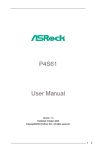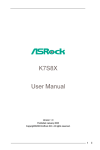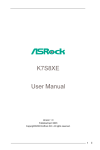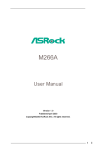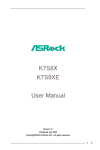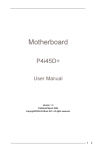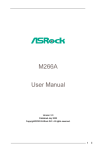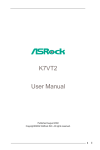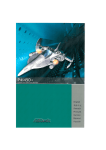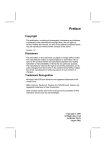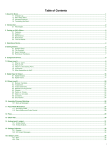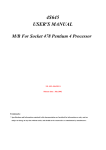Download P4I45D User Manual
Transcript
P4I45D User Manual Published October 2002 Copyright©2002 ASRock INC. All rights reserved. 1 Copyright Notice: No part of this manual may be reproduced, transcribed, transmitted, or translated in any language, in any form or by any means, except duplication of documentation by the purchaser for backup purpose, without written consent of ASRock Inc. Products and corporate names appearing in this manual may or may not be registered trademarks or copyrights of their respective companies, and are used only for identification or explanation and to the owners’ benefit, without intent to infringe. Disclaimer: Specifications and information contained in this manual are furnished for informational use only and subject to change without notice, and should not be constructed as a commitment by ASRock. ASRock assumes no responsibility for any errors or omissions that may appear in this manual. With respect to the contents of this manual, ASRock does not provide warranty of any kind, either expressed or implied, including but not limited to the implied warranties or conditions of merchantability or fitness for a particular purpose. In no event shall ASRock, its directors, officers, employees, or agents be liable for any indirect, special, incidental, or consequential damages (including damages for loss of profits, loss of business, loss of data, interruption of business and the like), even if ASRock has been advised of the possibility of such damages arising from any defect or error in the manual or product. ASRock Website: http://www.asrock.com 2 Contents 1 Introduction ................................................... 4 1.1 1.2 1.3 1.4 Package Contents ......................................................... Specifications ................................................................ Motherboard Layout ...................................................... ASRock I/OTM .................................................................. 4 4 6 7 2 Installation ..................................................... 8 2.1 2.2 2.3 2.4 2.5 2.6 2.7 2.8 Screw Holes ................................................................. Pre-installation Precautions ........................................... CPU Installation .............................................................. Installation of Heatsink and CPU fan ............................. Installation of Memory Modules (DIMM) ......................... Expansion Slots ............................................................. Jumpers Setup .............................................................. Connectors .................................................................... 8 8 8 9 9 10 11 11 3 BIOS Setup ..................................................... 14 3.1 BIOS Setup Utility ........................................................... 3.1.1 BIOS Menu Bar ....................................................... 3.1.2 Legend Bar ............................................................. 3.2 Main Menu ...................................................................... 3.3 Advanced, Security, Power, Boot, and Exit Menus ..... 14 14 14 15 17 4 Software Support ........................................... 18 4.1 Installing Operating System ........................................... 4.2 Support CD Information ................................................. 4.2.1 Running Support CD ............................................... 4.2.2 Drivers Menu .......................................................... 4.2.3 Utilities Menu ........................................................... 4.2.4 ASRock Live Demo Program .................................. 4.2.5 Contact Information ................................................ 18 18 18 18 18 18 18 Appendix: Advanced BIOS Setup ................... 19 1. 2. 3. 4. 5. Advanced Menu ............................................................... Security Menu ................................................................... Power Menu ..................................................................... Boot Menu ......................................................................... Exit Menu .......................................................................... 19 21 22 23 23 3 Chapter 1 Introduction Thank you for purchasing ASRock P4I45D motherboard, a reliable motherboard produced under ASRock’s consistently stringent quality control. It delivers excellent performance with robust design conforming to ASRock’s commitment to quality and endurance. Chapter 1 and 2 of this manual contain introduction of the motherboard and step-bystep installation guide for new DIY system builders. Chapter 3 and 4 contain basic BIOS setup and Support CD information. For advanced users’ reference, the Appendix offers more advanced BIOS setup information. 1.1 Package Contents ASRock P4I45D motherboard (ATX form factor: 12" x 9.6", 30.5 x 24.4 cm) ASRock P4I45D Quick Installation Guide ASRock Intel-Intel Series Support CD 1 Cable for IDE devices (1 x ATA 66/100) 1 Cable for floppy drive (1 x ribbon cable) 1 ASRock I/O shield 1.2 Specifications Platform: ATX form factor (12" x 9.6", 30.5 x 24.4 cm) CPU: Socket 478 for Intel® Pentium® 4/ Celeron® processor Chipsets: North Bridge: Intel® 845D chipsets, standard FSB 400 MHz, Max. 533 MHz; South Bridge: Intel® ICH2 Clock Generator: 100 MHz - 200MHz Memory: 2 slots for DDR: DIMM1 and DIMM2 (PC1600/ PC2100), Max. 2GB; 2 slots for SDR: DIMM3 and DIMM4 (PC100/ PC133), Max. 2GB IDE: IDE1: ATA 100 / Ultra DMA Mode 5; IDE2: ATA 100 / Ultra DMA Mode 5; Can connect up to 4 IDE devices Floppy Port: Supports floppy disk drive Audio: 5.1 channels AC’97 Audio LAN: Speed: 802.3u (10/100 Ethernet), supports Wake-On-LAN Hardware Monitor: CPU temperature sensing (ASRock U-COP); CPU overheat shutdown to protect CPU life (ASRock U-COP) (see CAUTION 1); Chassis temperature sensing; Voltage monitoring: +12V, +5V, +3V, Vcore; CPU fan tachometer; Chassis fan tachometer 4 PCI slots: AGP slot: USB 2.0: USB 1.1: ASRock I/OTM: BIOS: 5 PCI slots (see CAUTION 2) 1 AGP slot, supports 1.5v, 4X / 2X / 1X AGP card (see CAUTION 3) 2 default USB 2.0 ports and one extra set of USB 2.0 header to support two additional USB 2.0 ports upgrade 2 rear default USB 1.1 ports with legacy support (It is recommended to attach USB keyboard / mouse to the USB 1.1 ports: USB 2,3, see page 7 item 7.) PS/2: 1 keyboard port / 1 mouse port; 1 RJ 45 port; 2 rear default USB 1.1 ports; 2 rear default USB 2.0 ports; 1 serial port: COM1; 1 parallel port: ECP/EPP support; Audio Jack: Line Out/ Line In/ Microphone + 1 Game port AMI legal BIOS; Supports “Plug and Play”; ACPI 1.1 compliance wake up events; Supports jumperfree; SMBIOS 2.3.1 support; CPU frequency stepless control (only for advanced users’ reference, see CAUTION 4); Microsoft® Windows® 98 SE / ME / 2000 / XP compliant OS: CAUTION! 1. While CPU overheat is detected, the system will automatically shutdown. Please check if the CPU fan on the motherboard functions properly before you resume the system. To improve heat dissipation, remember to spray thermal grease between the CPU and the heatsink when you install the PC system. 2. PCI 5 supports PCI slave mode only [ DO NOT use the slot PCI 5 if there is USB device working on any of the USB 2.0 ports : USB 0,1 (see page 7, item 8) and USB 4,5 (see page 6, item 13). ] 3. Do NOT use 3.3v AGP card on P4I45D’s AGP slot! It may cause permanent damage! 4. Although P4I45D offers stepless control, it is not recommended to perform over clocking. Frequencies other than the recommended CPU bus frequency may cause the instability of the system or damage the CPU. 5 1.3 Motherboard Layout 1 4 2 3 5 26 6 24.4cm (9.6 in) CPU_FAN1 PS/2 ATXPWR1 Mic Mic in In 0 1 AUX1 2 3 0 1 2 3 30.5cm (12.0 in) GAME AUDIO1 AUDIO1 GAME GAME AUDIO1 23 24 20 Intel 845D Chipset 1 PS2_USB_PWR1 Line SDR DIMM1 (64 bit, 168-pin module) USB23 22 Line In in SDR DIMM2 (64 bit, 168-pin module) USB2 (USB1.1) USB3 (USB1.1) USB01 Line out DDR DIMM2 (64/72 bit, 184-pin module) LAN LAN DDR DIMM1 (64/72 bit, 184-pin module) USB0 (USB2.0) COM1 mPGA478B USB1 (USB2.0) PS/2 Keyboard PARALLEL PORT Mouse CD1 1 AUDIO1 25 AGP1 19 IDE2 Audio CODEC 8 PCI 1 PCI 2 Intel ICH2 IDE1 7 17 CLRCMOS1 21 PCI LAN 10 11 CMOS Battery 2MB BIOS PCI 4 P4I45D CHA_FAN1 PCI 5 14 15 16 17 18 19 20 21 22 23 24 25 26 IR1 1 13 ATX power connector (ATXPWR1) CPU socket CPU fan connector (CPU_FAN1) North Bridge controller 184-pin DDR DIMM slots (DDR1, DDR2, blue) 168-pin SDRAM DIMM slots (SDR1, SDR2, black) Primary IDE connector (IDE1, blue) Secondary IDE connector (IDE2, black) Chassis fan connector (CHA_FAN1) Floppy connector (FLOPPY1) BIOS FWH chip System panel connector (PANEL1) USB2.0 header (USB45) SPEAKER1 USB45 (USB2.0) 1 1 2 3 4 5 6 7 8 9 10 11 12 13 FLOPPY1 PCI 3 18 Super I/O 16 1 PLED 1 HDLED 14 PWRBTN RST 9 15 PANEL 1 12 Infrared module connector (IR1) Speaker connector (SPEAKER1) South Bridge controller CLRCMOS1 PCI slots Audio CODEC Front panel audio connector (AUDIO1) PCI LAN PS2_USB_PWR1 jumper Internal audio connectors: AUX1 (white) Internal audio connectors: CD1 (black) AGP slot CPU heatsink retention module 6 1.4 ASRock I/O TM 1 11 1 2 3 4 5 6 10 Parallel port RJ-45 port Game port Microphone (Pink) Line In (Light Blue) Line Out (Lime) 3 2 8 9 7 8 9 10 11 7 6 5 4 USB 1.1 ports (USB 2,3) USB 2.0 ports (USB 0,1) Serial port (COM1) PS/2 keyboard port (Purple) PS/2 mouse port (Green) 7 Chapter 2 Installation P4I45D is an ATX form factor (12" x 9.6", 30.5 x 24.4 cm) motherboard. Before you install the motherboard, study the configuration of your chassis to ensure that the motherboard fits into it. Make sure to unplug the power cord before installing or removing the motherboard. Failure to do so may cause physical injuries to you and damages to motherboard components. 2.1 Screw Holes Place screws into the holes indicated by circles to secure the motherboard to the chassis. Do not over-tighten the screws! Doing so may damage the motherboard. 2.2 Pre-installation Precautions Take note of the following precautions before you install motherboard components or change any motherboard settings. 1. 2. Unplug the power cord from the wall socket before touching any component. To avoid damaging the motherboard components due to static electricity, NEVER place your motherboard directly on the carpet or the like. Also remember to use a grounded wrist strap or touch a safety grounded object before you handle components. 3. Hold components by the edges and do not touch the ICs. 4. Whenever you uninstall any component, place it on a grounded antistatic pad or in the bag that comes with the component. Before you install or remove any component, ensure that the power is switched off or the power cord is detached from the power supply. Failure to do so may cause severe damage to the motherboard, peripherals, and/or components. 2.3 CPU Installation Step 1. Unlock the socket by lifting the lever up to a 90 angle. Step 2. Position the CPU directly above the socket such that its marked corner matches the base of the socket lever. Step 3. Carefully insert the CPU into the socket until it fits in place. The CPU fits only in one correct orientation. DO NOT force the CPU into the socket to avoid bending of the pins. 8 Step 4. When the CPU is in place, press it firmly on the socket while you push down the socket lever to secure the CPU. The lever clicks on the side tab to indicate that it is locked. Step 1 Step 2, 3 Step 4 2.4 Installation of CPU Fan and Heatsink Intel® Pentium®4 CPU requires larger heatsink and cooling fan. Thermal grease between the CPU and the heatsink is also needed to improve heat dissipation. Make sure that the CPU and the heatsink are securely fastened and in good contact with each other. For proper installation, please kindly refer to the instruction manuals of the CPU fan and heatsink vendors. 2.5 Installation of Memory Modules (DIMM) SDRAM (Synchronous DRAM) DIMM (Dual In-line Memory Module) has 168 pins and DDR (Double Data Rate) SDRAM DIMM has 184 pins. Please make sure to disconnect power supply before adding or removing DIMMs or the system components. 168-pin RAM 184-pin RAM The 168-pin SDRAM DIMM slot (black) and 184-pin DDR DIMM slot (blue) can be easily distinguished by the fool-proof design. Please do not use both 168-pin SDRAM DIMM and 184-pin DDR DIMM at the same time. To optimize the compatibility, it is not recommended to use two different models of the DIMMs at the same time. Step 1. Step 2. Unlock a DIMM slot by pressing the retaining clips outward. Align a DIMM on the slot such that the notch on the DIMM matches the break on the slot. 9 Step 3. Firmly insert the DIMM into the slot until the retaining clip snap back in place and the DIMM is properly seated. 2.6 Expansion Slots (PCI and AGP Slots) There are 5 PCI slots and 1 AGP slot on P4I45D motherboard. PCI slots: PCI slots are used to install expansion cards that have the 32-bit PCI interface. The slot PCI5 supports PCI slave mode only. Please do not use this slot while there is USB device working on any of the USB2.0 port: USB0,1 (see page 7, item 8) and USB4,5 (see page 6, item 13). AGP slot: The AGP slot is used to install a graphics card. The ASRock AGP slot has a special locking mechanism which can securely fasten the graphics card inserted. Please do not use 3.3v AGP card on P4I45D’s AGP slot! It may cause permanent damage. Installing an expansion card Step 1. Step 2. Step 3. Step 4. Step 5. Step 6. Before installing the expansion card, read the documentation of the expansion card and make necessary hardware settings for the card. Remove the system unit cover (if your motherboard is already installed in a chassis). Remove the bracket facing the slot that you intend to use. Keep the screw for later use. Align the card connector with the slot and press firmly until the card is completely seated on the slot. Fasten the card to the chassis with screws. Replace the system cover. 10 2.7 Jumpers Setup The illustration shows how jumpers are setup. When the jumper cap is placed on pins, the jumper is “SHORT”. If no jumper cap is placed on pins, the jumper is “OPEN”. The illustration shows a 3-pin jumper whose pin1 and pin2 are “SHORT” when jumper cap is placed on these 2 pins. Jumper PS2_USB_PWR1 (see p.6 item 22) Setting Description Short pin2, pin3 to set at +5VSB (standby) and +5V +5VSB enable PS/2 or USB wake up (Default) events. Note: To select +5VSB, it requires 2 Amp and higher standby current provided by power supply. CLRCMOS1 Disconnect the power cord, (see p.6 item 17) then short the solder points solder points to clear CMOS by using metal material, e.g., a paper clip. Note: There are SOLER POINTS but no PINS on CLRCMOS1. 2_3 1_2 2.8 Connectors Connectors are NOT jumpers. DO NOT place jumper caps over these connectors. Connector Figure Description FDD connector (33-pin FLOPPY1) FLOPPY1 Pin1 Red marking (see p.6 item 10) Note: Match the red marking on the floppy ribbon cable with Pin1. Primary IDE connector (Blue) Secondary IDE connector (Black) (39-pin IDE1, see p.6 item 7) (39-pin IDE2, see p.6 item 8) PIN1 IDE1 PIN1 IDE2 Connect this BLACK end to the IDE devices Connect this BLUE end to the motherboard 80-Pin ATA 100 cable 11 Note: To optimize compatibility and performance, please connect your hard disk drive to the primary IDE connector (IDE1, blue) and CD-ROM to the secondary IDE connector (IDE2, black). USB_PWR USB2.0 header ASRock I/OTM on P4I45D motherP-5 P+5 GND DUMMY (9-pin USB45) (see p.6 item 13) 1 GND P+4 P-4 USB_PWR Infrared module connector (5-pin IR1) (see p.6 item 14) IRTX +5V DUMMY 1 GND IRRX Internal audio connectors (4-pin CD1, 4-pin AUX1) (CD1: see p.6 item 24) (AUX1: see p.6 item 23) Front panel audio connector (9-pin AUDIO1) (see p.6 item 20) AUX-R GND GND AUX-L AUX1 CD-R GND GND CD-L CD1 GND +5VA BACKOUT-R BACKOUT-L 1 AUD-OUT-L DUMMY AUD-OUT-R MIC-POWER MIC System panel connector (9-pin PANEL1) (see p.6 item 12) PLED+ PLEDPWRBTN# GND board provides you 2 default USB2.0 ports and 2 default USB1.1 ports. If the default USB ports on the rear panel are not sufficient, an extra USB2.0 header is available to support 2 additional USB2.0 ports. This connector supports an optional wireless transmitting and receiving infrared module. These connectors allow you to receive stereo audio input from sound sources such as a CD-ROM, DVD-ROM, TV tuner card, or MPEG card. This is an interface for front panel audio cable that allows convenient connection and control of audio devices. This connector accommodates several system front panel functions. 1 DUMMY RESET# GND HDLEDHDLED+ External speaker connector (4-pin SPEAKER 1) (see p.6 item 15) Chassis fan connector (3-pin CHA_FAN1) (see p.6 item 9) 1 SPEAKER DUMMY DUMMY +5V GND +12V CHA_FAN_SPEED This connector allows you to attach to an external speaker. Connect the fan cable to the connector matching the black wire to the ground pin. 12 CPU fan connector (3-pin CPU_FAN1) (see p.6 item 3) ATX power connector (20-pin ATXPWR1) (see p.6 item 1) GND +12V CPU_FAN_SPEED Connect the fan cable to the connector matching the black wire to the ground pin. Connect an ATX power supply to the connector. 13 Chapter 3 BIOS Setup 3.1 BIOS Setup Utility This section explains how to configure your system using the BIOS Setup Utility. The BIOS FWH chip on the motherboard stores the BIOS Setup Utility. When you start up the computer, there is a chance for you to run the BIOS Setup. Press <F2> during the Power-On-Self-Test (POST) to enter the BIOS Setup Utility, otherwise, POST continues with its test routines. If you wish to enter the BIOS Setup after POST, restart the system by pressing <Ctl> + <Alt> + <Delete>, or by pressing the reset button on the system chassis. You can also restart by turning the system off and then back on. The BIOS Setup Utility is designed to be user-friendly. It is a menu-driven program, which allows you to scroll through its various sub-menus and select among the predetermined choices. Because the BIOS software is constantly being updated, the following BIOS setup screens and descriptions are for reference purpose only, and may not exactly match what you see on your screen. 3.1.1 BIOS Menu Bar The top of the screen has a menu bar with the following selections: MAIN Sets up the basic system configuration ADVANCED Sets up the advanced features SECURITY Sets up the security features POWER Configures Power Management features BOOT Configures the default system device that is used to locate and load the Operating System EXIT Exits the current menu or the BIOS Setup To access the menu bar items, press the right or left arrow key on the keyboard until the desired item is highlighted. 3.1.2 Legend Bar At the bottom of the Setup Screen is a legend bar. The following table lists the keys in the legend bar with their corresponding functions. 14 Navigation Key(s) <F1> <ESC> / / +/<Enter> <F9> <F10> Function Description Displays the General Help Screen Jumps to the Exit menu or returns to the upper menu from the current menu Moves cursor up or down between fields Selects menu to the left or right Increases or decreases values Brings up a selected menu for a highlighted field Resets the current screen to its Setup Defaults Saves changes and exits Setup 3.2 Main Menu When you enter the BIOS Setup Utility, the following screen appears. Main Advanced System Date System Time AMIBIOS SETUP UTILITY - VERSION 3.31a Boot Power Exit Security Oct 29 2002 Tue 22:07:40 Floppy Drives IDE Devices BIOS Version Processor Type Processor Speed Cache Size Microcode Update Total Memory DDR1 DDR2 SDR1 SDR2 F1:Help Esc:Exit [ Setup Help ] Month: Jan - Dec Day: 01 - 31 Year: 1980 - 2099 P4I45D BIOS L1.00 Pentium (R) 4 Family CPU 2400 MHz 512 KB F24 / 0F 128 MB 128 MB / 266 MHz None None None :Select Item :Select Menu +/-:Change Values Enter:Select Sub-Menu F9:Setup Defaults F10:Save & Exit System Date [Month/Day/Year] Set the system date that you specify. Valid values for month, day, and year are Month: (Jan to Dec), Day: (1 to 31), Year: (up to 2099). Use keys to move between the Month, Day and Year fields. System Time [Hour:Minute:Second] Set the system to the time that you specify. Use keys to move between the Hour, Minute and Second fields. Floppy Drives Use this to set the type of floppy drives installed. IDE Devices Use this to configure IDE devices. 15 TYPE It allows user to select the type of the IDE Drive. Below are the configuration options. After making your selections on this sub-menu, press <ESC> key to return to the upper menu, in whcih the hard disk drive field will display the size for the hard disk drive that you configured. [USER]: It allows user to manually enter the number of cylinders, heads, and sectors per track for the drive. Before attempting to configure a hard disk drive, make sure you have the correct configuration information supplied by the drive manufacturer. Incorrect settings may cause the system to fail to recognize the installed hard disk. [Auto]:Select [Auto] to automatically detect hard disk drive. If auto-detection is successful, the BIOS Setup automatically fills in the correct values for the remaining fields on this sub-menu. If the autodetection fails, it may due to that the hard disk is too old or too new. If the hard disk was already formatted on an older system, the BIOS Setup may detect incorrect parameters. In these cases, select [User] to manually enter the IDE hard disk drive parameters. After entering the hard disk information into BIOS, use a disk utility, such as FDISK, to partition and format new IDE hard disk drives. This is necessary so that you can write or read data from the hard disk. Make sure to set the partition of the Primary IDE hard disk drives to active. 16 [CD/DVD]: This is used for IDE CD/DVD drives. [ARMD]: This is used for IDE ARMD (Accelerated RemovableMedia Device), such as MO. Cylinders This is used to configure the number of cylinders. Refer to the drive documentation to determine the correct value. Heads This is used to configure the number of read/write heads. Refer to the drive documentation to determine the correct values. Write Pre-compensation Enter Write Pre-compensation sector. Refer to the drive documentation to determine the correct value. Sectors This is used to configure the number of sectors per track. Refer to the drive documentation to determine the correct value. Maximum Capacity This field shows the drive’s maximum capacity as calculated by the BIOS based on the drive information you entered. LBA Mode This allows user to select the LBA mode for a hard disk > 512 MB under DOS and Windows; for Netware and UNIX user, select [Off] to disable the LBA mode. Block Mode Set the block mode to [On] will enhance hard disk performance by reading or writing more data during each transfer. Fast Programmed I/O Modes This allows user to set the PIO mode to enhance hard disk performance by optimizing the hard disk timing. 32 Bit Transfer Mode It allows user to enable 32-bit access to maximize the IDE hard disk data transfer rate. Ultra DMA Mode Ultra DMA capability allows improved transfer speeds and data integrity for compatible IDE devices. Set to [Disabled] to suppress Ultra DMA capability. 3.3 Advanced, Security, Power, Boot, and Exit Menus Detailed descriptions of these menus are listed in the Appendix, see p.19. 17 Chapter 4 Software Suppor Supportt 4.1 Install Operating System This motherboard supports various Microsoft® Windows® operating systems: 98 SE/ ME/ 2000/ XP. Because motherboard settings and hardware options vary, use the setup procedures in this chapter for general reference only. Refer to your OS documentation for more information. 4.2 Support CD Information The Support CD that came with the motherboard contains necessary drivers and useful utilities that enhance the motherboard features. 4.2.1 Running The Support CD To begin using the support CD, insert the CD into your CD-ROM drive. The CD automatically displays the Main Menu if “AUTORUN” is enabled in your computer. If the Main Menu did not appear automatically, locate and double click on the file ASSETUP.EXE from the BIN folder in the Support CD to display the menus. 4.2.2 Drivers Menu The Drivers Menu shows the available devices drivers if the system detects installed devices. Install the necessary drivers to activate the devices. 4.2.3 Utilities Menu The Utilities Menu shows the applications software that the motherboard supports. Click on a specific item then follow the installation wizard to install it. 4.2.4 ASRock PC-DIY Live Demo Program ASRock presents you a multimedia PC-DIY live demo, which shows you how to install your own PC system step by step. You can find the file through the following path: ..\ MPEGAV \ AVSEQ01.DAT To see this demo program, you can run Microsoft Media Player to play the file. 4.2.5 Contact Information If you need to contact ASRock or want to know more about ASRock, welcome to ASRock’s website: http://www.asrock.com; or you may contact your dealer for further information. 18 Appendix: Advanced BIOS Setup This section will introduce you the following BIOS Setup menus: “Advanced,” “Security,” “Power,” “Boot,” and “Exit.” 1. Advanced BIOS Setup Menu Main Advanced AMIBIOS SETUP UTILITY - VERSION 3.31a Boot Power Exit Security Spread Spectrum CPU Host Frequency Actual Frequency CPU Ratio Selection SDRAM Frequency Hyper Threading Technology Disabled Auto 133MHz 20.0x Auto Auto [ Setup Help ] <Enter> to enable or disable the feature of spread spectrum Chipset Configuration Resource Configuration Peripheral Configuration System Hardware Monitor F1:Help Esc:Exit :Select Item :Select Menu +/-:Change Values Enter:Select Sub-Menu F9:Setup Defaults F10:Save & Exit Spread Spectrum: This field should always be [Disabled] for better system stability. CPU Host Frequency: [Auto]: The motherboard detects the jumper setup and sets the CPU host frequency automatically. [Manual]: This allows user to set CPU host frequency manually. However, this is not recommended unless user thoroughly knows the feature. Wrong setup may cause problems during operation. CPU Ratio Selection: Use this to set the multiple that times the frontside bus frequency must equal to the core speed of the installed processor. SDRAM Frequency: If [Auto] is selected, the motherboard detects the memory module(s) inserted and automatically assigns appropriate frequency. You can also select other value as operating frequency: [200MHz], [266MHz]. Hyper Threading Technology: To enable this feature, it requires a computer system with an Intel Pentium®4 processor at 3.06 GHz or higher and an operating system that includes optimization for this technology, such as Microsoft® Windows® XP. Set to [Auto] if using Microsoft® Windows® XP, or Linux kernel version 2.4.18 or higher. 19 Chipset Configuration: AGP Aperture Size: It refers to a section of the PCI memory address range used for graphics memory. We recommend that you leave this field at the default value unless your AGP card requires other sizes. ICH Delayed Transaction: Select [Enable] will enable delayed transactions for internal register, FWH, and LPC interface accesses. USB Controller: Use this to enable or disable the use of USB controller. USB Device Legacy Support: Use this to enable or disable support to emulate legacy I/O devices such as mouse, keyboard,... etc. Resource Configuration: PCI Latency Timer (PCI Clocks): The default is 32. We recommend you to keep the default value unless your PCI expansion cards’ specifications require other settings. Primary Graphics Adapter: Select PCI or AGP as the primary graphics adapter. Peripheral Configuration: OnBoard FDC: Use this to enable or disable floppy drive controller. OnBoard Serial Port: Use this to set addresses for the onboard serial ports or disable serial ports. Configuration options: [Auto], [Disabled], [3F8 / IRQ4 / COM1], [2F8 / IRQ3 / COM2], [3E8 / IRQ4 / COM3], [2E8 / IRQ3 / COM4]. OnBoard Infrared Port: This allows you to enable or disable the onboard infrared port feature. Select [Auto] will enable this feature if the infrared module is installed. OnBoard Parallel Port: Select Parallel Port address or disable Parallel Port. Configuration options: [Auto], [Disabled], [378], [278]. Parallel Port Mode: Set the operation mode of the parallel port. OnBoard Midi Port: Select address for Midi Port or disable Midi Port. Configu ration options: [Disabled], [330], [300], [310], [320]. Midi IRQ Select: Use this to select Midi IRQ. Configuration options: [3], [4], [5], [7], [10], [11]. 20 OnBoard Game Port: Select address for Game Port or disable Game Port. Configuration options: [200], [208], [Disabled]. OnBoard IDE: To enable either the primary IDE channel or the secondary IDE channel, set to [Disabled] will disable the both. Configuration options: [Disabled], [Primary], [Secondary], [Both]. OnBoard LAN: Enable or Disable onboard LAN. OnBoard AC’97 Audio: Enable or disable onboard AC’97 audio feature. System Hardware Monitor: You can check the status of the hardware on your system. It allows you to monitor the parameters for CPU temperature, Motherboard temperature, CPU fan speed, and critical voltage. 2. Security Setup Menu Supervisor Password: This field shows the status of the Supervisor Password. [Clear]: No password has been set. [Set]: Supervisor password has been set. User Password: This field shows the status of the User Password. [Clear]: No password has been set. [Set]: User password has been set. Set Supervisor Password: Press <Enter> to set Supervisor Password. Valid password can be a 1 to 6 alphanumeric characters combination. If you already have a password, you must enter your current password first in order to create a new password. Set User Password: Press <Enter> to set User Password. Valid password can be a 1 to 6 alphanumeric characters combination. If you already have a password, you must enter your current password first in order to create a new password. Password Check: Select the check point for “Password Check”. Configuration options: [Setup], [Always]. If [Setup] option is selected, the “Password Check” 21 is performed before BIOS setup. If [Always] option is selected, the “Password Check” is performed before both boot-up and BIOS setup. 3. Power Setup Menu Suspend to RAM (S3): This field allows you to select whether to auto-detect or disable the ACPI Suspend-to-RAM feature. Select [Auto] will enable this feature if the system supports it. Repost Video on S3 Resume: This feature allows you to repost video on S3 resume. It is recommended to enable this feature under Microsoft® Windows® 98 / ME. Restore on AC/Power Loss: This allows you to set the power state after an unexpected AC/power loss. If [Power Off] is selected, the AC/power remains off when the power recovers. If [Power On] is selected, the AC/power resumes and the system starts to boot up when the power recovers. Ring-In Power On: Use this to enable or disable Ring-in signals to turn on the system from the power-soft-off mode. PME# Power On: Use this to enable or disable PCI PME# to turn on the system from the power-soft-off mode. Keyboard Power On: Use this to enable or disable keyboard to turn on the system from the power-soft-off mode. RTC Alarm Power On: Use this to enable or disable RTC(Real Time Clock) to power on the system. If [Enable] is selected, you must fill the RTC Alarm Date / Hour / Minute / Second sub-fields with the actual wake up time you desire. 22 4. Boot Setup Menu Quick Boot Mode: This mode speeds up the boot-up routine by skipping memory retestings. Boot-time Diagnostic Screen: This screen shows CPU and hardware information during Power-On-Self-Test (POST) routine. If this screen is disabled, only ASRock logo is shown during the boot up process. Boot Up Num-Lock: This automatically activates the Numeric Lock function after boot up. Boot to OS/2: This enables boot up to OS/2 operating system. Boot Device Priority: This allows you to set the boot device priority. 5. Exit Menu 23 Exit Saving Changes: After you enter the sub-menu, the message “Save current settings and exit” will appear. If you press <ENTER>, it will save the current settings and exit the BIOS SETUP Utility. Exit Discarding Changes: After you enter the submenu, the message “Quit without saving changes” will appear. If you press <ENTER>, you will exit the BIOS Setup Utility without making any changes to the settings. Load Default Settings: This loads the default values for all the setup configuration. Discard Changes: After you enter the sub-menu, the message “Load setup original values” will appear. If you press <ENTER>, original values will be restored. All changes are discarded. 24
























